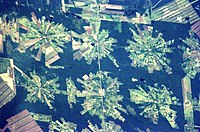
Photo from wikipedia
Context As agricultural demands for land continues to expand, strategies are urgently needed to balance agricultural production with biodiversity conservation and ecosystem service provision in agricultural landscapes. Objectives We used… Click to show full abstract
Context As agricultural demands for land continues to expand, strategies are urgently needed to balance agricultural production with biodiversity conservation and ecosystem service provision in agricultural landscapes. Objectives We used a factorial landscape design to assess the relative contributions of forest proximity and local forest cover to bee diversity and the provision of coffee pollination services. Methods We quantified bee diversity and fruit set in 24 sun-grown coffee fields in Southeast Region of Brazil that were selected following a factorial sampling design to test the independent effects of local forest cover (in a radius of 400 m) and proximity to forest fragments. To assess the impact of landscape simplification, we also evaluated local coffee cover. Results Bee richness and abundance were higher in the proximity of forest fragments, but only bee abundance decreased when the coffee cover dominated the surrounding landscapes. Coffee fruit set was 16% higher overall with bee visitations compared with bee exclusion and increased to 20% when coffee bushes were near forest fragments, and the coffee cover was low. Surprisingly, local forest cover did not affect the bee community or coffee fruit set. Conclusion Our results provide clear evidence that the proximity of coffee crops to forest fragments can affect the abundance and richness of bees visiting the coffee flowers and thereby facilitate the provision of pollination services. The positive association between forest proximity and fruit set reinforces the importance of natural vegetation in enhancing bee diversity and, therefore, in the provision of pollination services. The negative effect of coffee cover on fruit set at the local scale suggests that the service demand can surpass the capacity of pollinators to provide it. These effects were independent of the local forest cover, although all studied landscapes had more than 20% remaining forest cover (within a 2 km radius), which is considered the extinction threshold for Atlantic Forest species. Interspersion of forest fragments and coffee plantations in regions with more than 20% of forest cover left could thus be a useful landscape management target for facilitating pollinator flows to coffee crops and thus for increasing coffee yields.
Journal Title: Landscape Ecology
Year Published: 2020
Link to full text (if available)
Share on Social Media: Sign Up to like & get
recommendations!